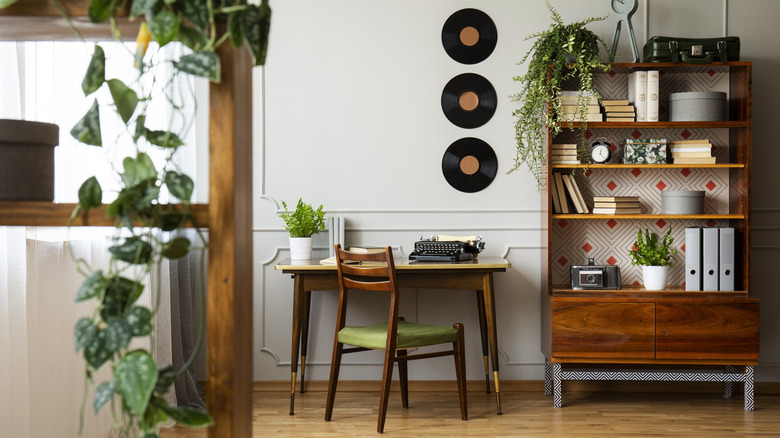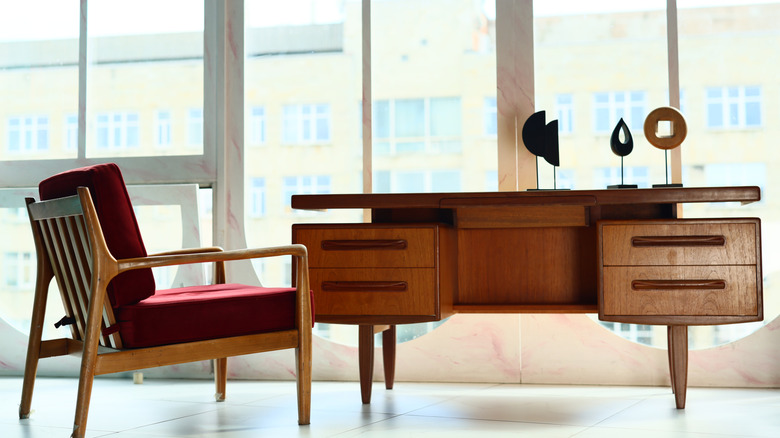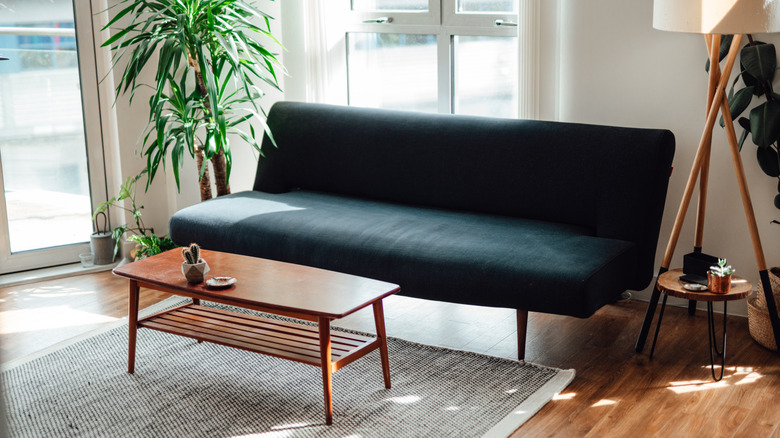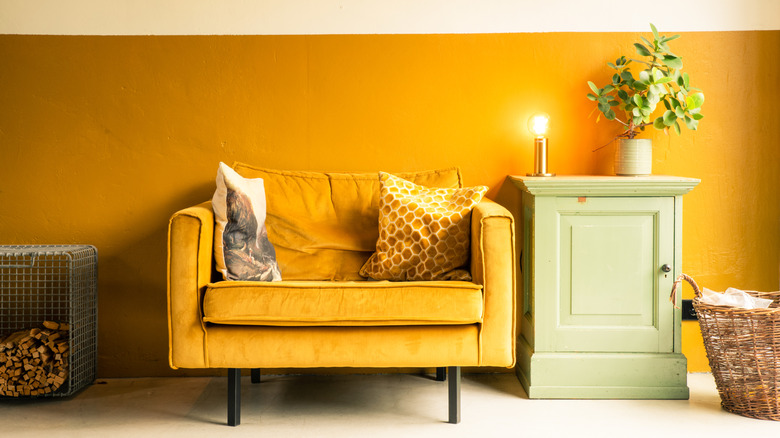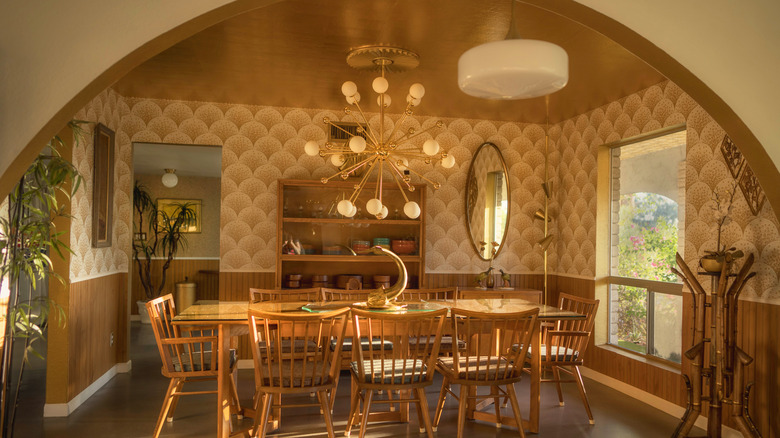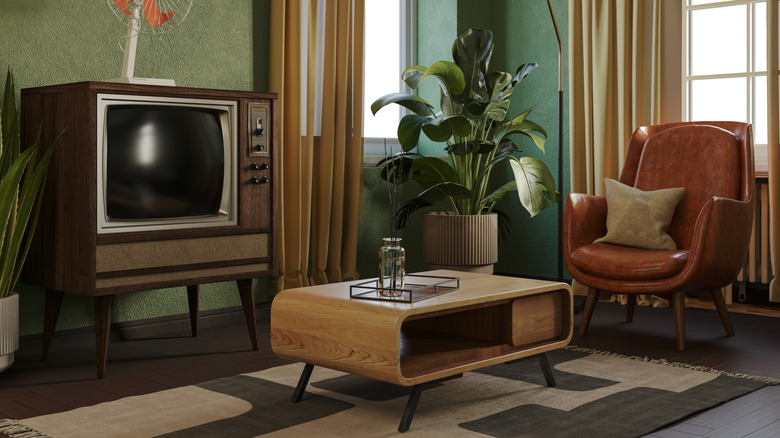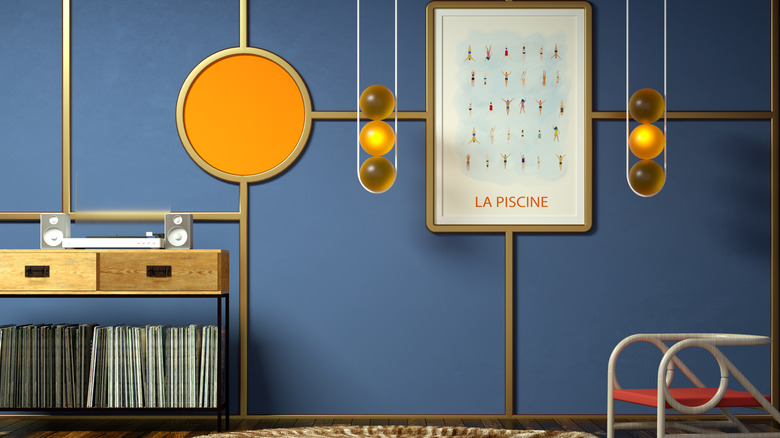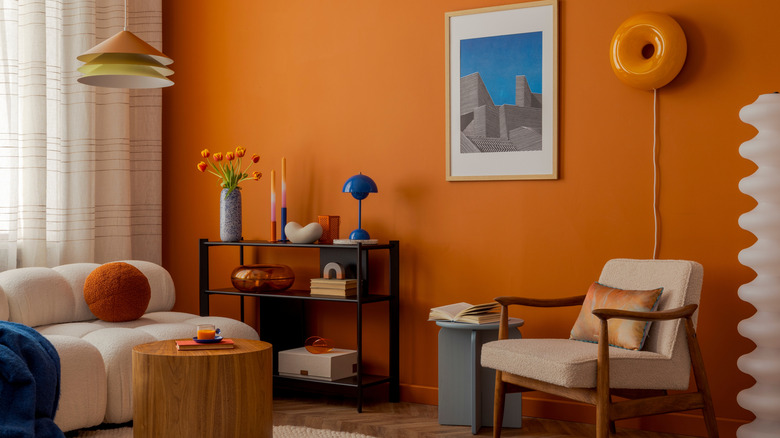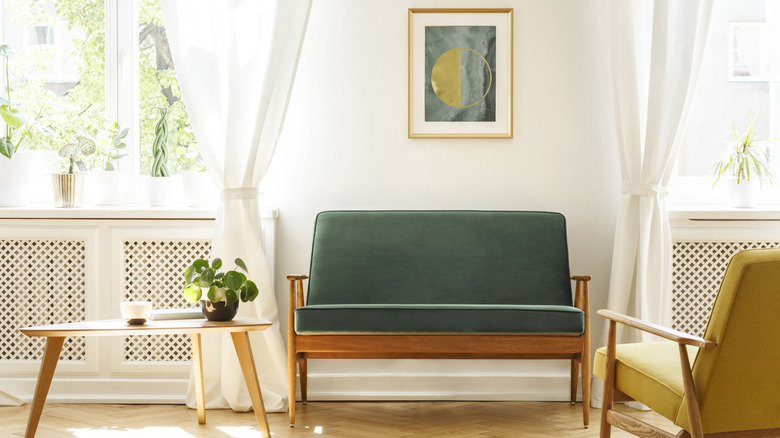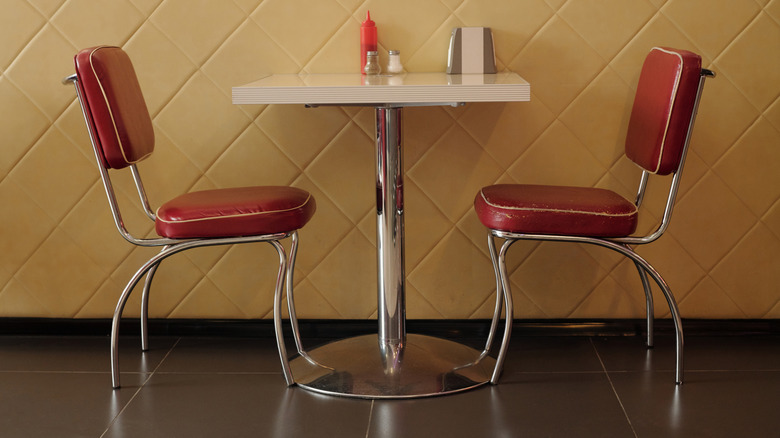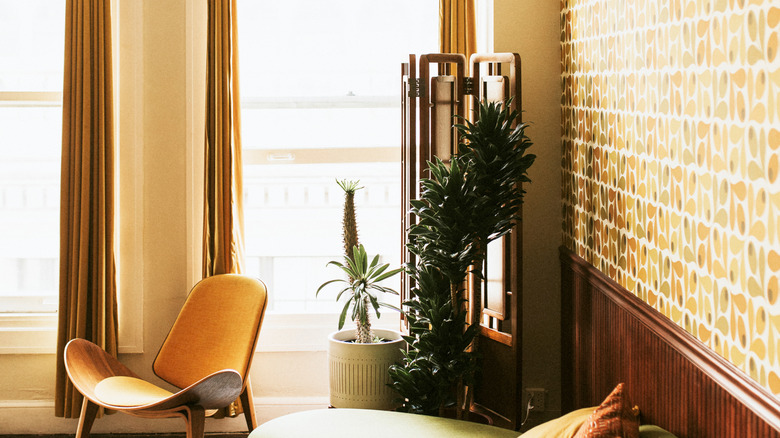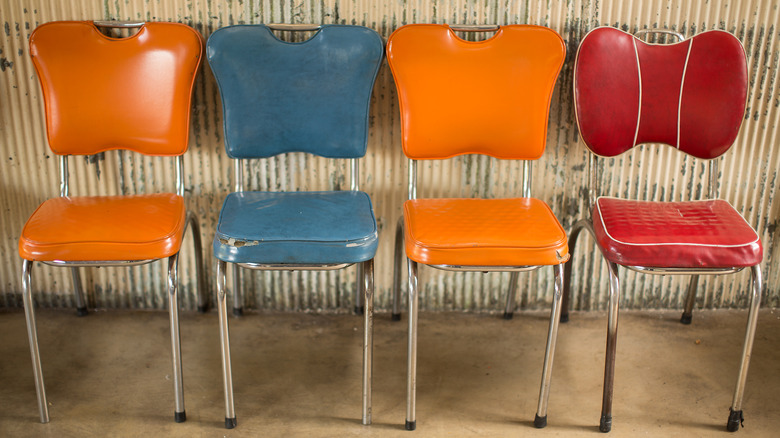What To Keep In Mind When Styling A Home With Mid-Century Modern Decor
We may receive a commission on purchases made from links.
If you stay true to its original approach, mid-century modern decor will never go out of style. This iconic style has gone through several iterations since its genesis, but the trendy takes on it haven't had the same longevity as the foundational aesthetic. The truth is, everyone thinks of something slightly different when they picture a mid-century modern space. Even if you believe that the style isn't suitable for your home, certain design approaches might positively surprise you.
I've had the unique opportunity to restore my own mid-century home in the California desert. The home was originally built in 1960, and I felt it was crucial to study the style in its entirety. I was lucky enough that many of the original elements, including Formica countertops and a tiled bathroom, had been well-preserved. However, some alterations were required to bring it back to its former glory. There are a few key principles that can make a huge difference in your space. In its essence, mid-century modern design is about fostering a connection to the surrounding environment while blending functionality with modern geometric shapes. Luckily, it's a versatile style that you can put your spin on when injecting it into your own home, while keeping a few things in mind.
Always try refinishing furniture before painting it
The first rule in mid-century modern decor is to (almost) never paint over your solid wood furniture. If there is any chance of refinishing the piece and staining it back to its original splendor, it's imperative to try. Although one might credit Danish and Scandinavian interiors for the concept of warm minimalism, the style was also influenced by the Japanese. This gave birth to what we know as "Japandi" design, an aesthetic that had a heavy influence on mid-century interiors in America. One of these recurring themes is the integration and preservation of natural materials.
If your wood furniture has already been painted, consider stripping the paint and embracing the natural grain. To restore painted wood furniture, first apply a paint stripper, like Citristrip Stripping Gel, and let it sit until the paint peels. Gently scrape off the paint with a plastic scraper before wiping the surface clean and letting it dry. If you are working with an unpainted piece, you can start by sanding the wood with medium, then fine-grit sandpaper, always moving with the grain. Finally, apply a wood stain after testing a small area to ensure you like the finish. Seal the piece with Danish oil, tung oil, or a clear polyurethane to protect and highlight the surface. For a more comprehensive guide on the process, here's everything you will need for refurbishing your wooden furniture.
Wood is great, but only if you choose the right tone
Beyond embracing natural wood grain furniture, it's crucial to choose the right shade and finish. Teak, walnut, and oak were common throughout the era, and a focus on warm wood shades was ever-present. Rosewood was another popular material, but it tended to be used on rarer, pricier pieces. Overall, wooden furniture from the mid-century design period is warm-toned and rich. So, avoid whitewashing or any grey, overly cool undertones.
One foolproof way to ensure your wooden furniture looks authentic is by sourcing original pieces. When it comes to how to successfully buy vintage furniture for your home, there are a few tips to keep in mind. Pay attention to details like solid wood construction, dovetail joints, and original maker's marks or labels from brands like Drexel, American of Martinsville, or Broyhill. Avoid anything made of MDF or laminate backing unless it's part of a period-specific design. If genuine pieces are out of your price range, you can visit your local vintage furniture shop and ask the shopkeepers which pieces are from the mid-century era. This will give you an idea of silhouettes to look for and the right wood tones. Seeing these natural tones in person will help you develop a better sense of which colors and finishes create that authentic mid-century warmth.
Don't let going mid-century modern make you shy away from color
For those who think that mid-century decor is boring, you might be misinformed about the authentic aesthetic. There is a common misconception that the minimalism of the style means an entirely neutral color palette. This theory is totally wrong. In fact, mid-century modern homes incorporated colors that were previously unused in residential design. So, think about boosting the authenticity of your decor by adding pops of lime green, bright yellow, turquoise blue, and atomic orange.
In order to strike the perfect balance between organic and dynamic decor, start with a warm, neutral base. If you feel like neon shades like lime green will overwhelm your space, you can opt for earthier variations like olive, mustard, and rust. Another option is to incorporate primary colors into your palette with hues like red, dark blue, and sunflower yellow. In general, the key is to add rich contrast through pops of saturated shades. If you aren't sure which accent colors will best suit your space, experiment with changeable items like textiles. For example, these Lush Decor Mid-Century Curtains can brighten up your space with the style's iconic colors.
Your lighting should act as a major accent piece
When designing a mid-century modern-inspired home, never neglect the lighting. In spite of the ever-present minimalist theme, mid-century homes frequently incorporated a statement light – be it a Sputnik chandelier or an Arco floor lamp. Proper lighting selection is essential for balancing form and function, reinforcing the overall design ethos of simplicity combined with distinctive accents.
To add statement lighting to your space, consider installing a bold pendant or chandelier in central areas like the dining room or living room where it can serve as a visual anchor. In rooms without the ceiling height or wiring for a chandelier, opt for sculptural floor lamps, such as a dramatic arch or tripod style, to maintain the mid-century flair. Table lamps with geometric bases or globe shades work well on side tables or desks. A design inspired by the iconic Verner Panton Flowerpot Lamp, like this Cyggyll Flowerpot Lamp, is another space-saving option that still makes a major visual impact.
Furniture should always be low to the ground
Many mid-century homes were built with low ceilings, but there was a secret to preventing the single-level homes from feeling cramped. The furniture was almost exclusively low-to-the-ground. Low-slung furniture can help to create a sleek, simple look that doesn't take up vertical space. In addition to picking pieces that adhere to this compact approach, you could also switch out the legs of your current furniture for shorter variations.
There are a few famous furniture pieces that exemplify the low-slung look. The Barcelona Chair by Ludwig Mies van der Rohe and Lilly Reich was a unique collaboration as it involved a credited female designer. Although it was first exhibited in 1929, the low-slung armchair remained popular throughout the mid-century, especially in American homes. Iconic modern brand, Fler, also offers several sleek, low-profile sofas. If you're searching for modern alternatives, look for features like angular frames, tapered legs, and streamlined silhouettes. Complete your space with a piece from the top 10 furniture ideas for a mid-century modern home.
Dare to mix both clean lines and curved shapes
Curved decor tends to be seen as retro (although it has had a comeback in recent years), whereas decor with clean lines often appears modern. However, the mid-century modern aesthetic promotes a balance of classic and contemporary shapes by mixing curves with clean lines. Many iconic furniture pieces, like the Noguchi Coffee Table and the Womb Chair by Eero Saarinen, exemplify this juxtaposition.
To incorporate this concept into your home, consider pairing a low-profile, angular sofa with a rounded coffee table. In addition to the Noguchi Coffee Table, classics like the Saarinen Tulip Coffee Table or the sculptural Platner Coffee Table by Warren Platner are perfect examples. You could also mix circular side tables alongside a clean-lined piece like a credenza. Or, play off a curved mirror or round wall art with rectangular shelving to create visual interest. The key is to let one or two curved elements offset the linearity.
Try not to get stuck in a symmetrical mindset
There's a reason why mid-century modern decor appears simple but not sterile. One of the ways designers created visual variation was through asymmetry. By arranging your furniture in an unexpected layout, you will instantly achieve a more interesting look. Try placing a sleek armchair next to an angled sectional, and use the "rule of three" to ensure you don't decorate in pairs.
An asymmetrical interior doesn't mean unbalanced. The trick to nailing the mid-century modern aesthetic is to balance organic forms with clean lines and strategically-placed focal points. Statement pieces, like a sculptural piece of decor, should anchor the room. If your decor appears mirrored, it can feel impersonal and unwelcoming. Because mid-century furniture is already minimalistic by nature, the arrangement is imperative so your home doesn't feel staged. There should be elements of surprise throughout the space, leaning into the playful feel of the style. Although it's sleek and timeless, it's important to note that mid-century interiors don't take themselves too seriously.
Stay away from heavy drapes and go for simple treatments
We can't all adjust the architecture of our homes to achieve that iconic floor-to-ceiling window look. However, you can make a few key adjustments to maximize natural light. Mid-century modern homes are all about highlighting the connection between the interior and exterior. That means you should stay away from heavy drapery and use simpler window treatments like minimalist blinds or airy curtains. When choosing window treatments, prioritize materials and colors that feel light, like linen, cotton, or woven shades in neutral tones. If privacy is a concern, opt for layered sheer panels or adjustable blinds that still allow light to filter through during the day.
Artificial light can also help you lean into the mid-century mood. There are a few top tips for getting good lighting in every room in your home. For example, overhead lighting – particularly recessed lighting – was not a feature in mid-century interiors. Lamps of different heights and sizes are key to creating a glowing ambiance. Warm-toned bulbs are also essential for a timeless look, as bright white bulbs will look modern, garish, and unwelcoming.
Don't forget about the importance of metal accents
It's easy to get lost in the natural, organic approach to mid-century modern design. Although natural materials and a connection to the outdoors were important, industrial touches were also common. For example, countless fundamental mid-century modern chairs were crafted with chrome metal frames. The metallic sheen adds a textural variation that creates visual interest in your space.
Search for furniture and decor with metal details, like a chrome-legged coffee table, a silver floor lamp, or wall-mounted shelving with metal brackets. Mix these shiny accent pieces with wood, leather, and natural textiles to keep the room grounded while adding a splash of industrial contrast. Even small elements like picture frames or decorative accents can nod to the metallic side of mid-century style without overwhelming the room. For example, a gold vase atop a wood table or shelf will add an interesting contrast and pop of glam.
Get to know the mid-century modern patterns
The mid-century design era introduced a whole host of funky, daring patterns. From wallpaper to upholstery, the designs featured abstract geometrics and playful graphic motifs. These patterns were inspired by the atomic age and the theory of retrofuturism. Homeowners and designers began predicting what future homes would look like in a space age era, and that bled over into everyday design. A few iconic motifs include the starburst, amoeba, boomerang, and the Eames Dot Pattern.
You can add splashes of these patterns with throws, pillow shams, or even wall decals. If you are hesitant to fill your main living space with such playful adornments, consider experimenting in a small or transitional space like a powder room or hallway. Another option is to try wall decor like this LiveInUrban Mid-Century Modern PVC Panel. This is one period-appropriate way to decorate your walls without using framed art. As with anything that is easily removable, wall decorations are a great way to allow you to get a feel for a style without major commitment.
Embrace an artificial touch with vinyl furniture
Plastic production took off after World War II, making the mid-20th century the prime time for plastic packaging, decor, and more. Vinyl furniture was huge in the 1960s, so if you want to recreate an authentic interior, try incorporating a few vintage vinyl pieces. After all, if you lean into the organic decor too heavily, your home can become boho-chic rather than mid-century modern. So, explore furniture like wooden dining chairs with vinyl seats for a subtle hint of artificial texture.
There are a few pros and cons of vinyl furniture. The biggest pro leans into the functionality of mid-century decor — it's super easy to clean. Unlike other upholstery, you can just wipe off the surface without the risk of staining. However, if there is any major damage like a tear, it can be tough to repair. As far as the price, a vintage vinyl sofa in good condition can run you over a few thousand dollars, but you can get the look with modern copycats. For example, this AWQM Mid-Century Modern Solid Loveseat has a vinyl-like, synthetic leather surface and a sleek frame.
